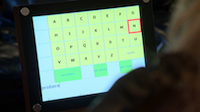Members Login

Channels
Special Offers & Promotions
Paralyzed ALS Patient Operates Speech Computer with her Mind
In the UMC Utrecht a brain implant has been placed in a patient enabling her to operate a speech computer with her mind.
 The researchers and the patient worked intensively to get the settings right. She can now communicate at home with her family and caregivers via the implant. That a patient can use this technique at home is unique in the world. This research was published in the New England Journal of Medicine.
The researchers and the patient worked intensively to get the settings right. She can now communicate at home with her family and caregivers via the implant. That a patient can use this technique at home is unique in the world. This research was published in the New England Journal of Medicine.
Because she suffers from ALS disease, the patient is no longer able to move and speak. Doctors placed electrodes in her brain, and the electrodes pick up brain activity. This enables her to wirelessly control a speech computer that she now uses at home.
“This is a major breakthrough in achieving autonomous communication among severely paralyzed patients whose paralysis is caused by either ALS, a cerebral hemorrhage or trauma,” says Professor Nick Ramsey, professor of cognitive neuroscience at the University Medical Center (UMC) Utrecht. “In effect, this patient has had a kind of remote control placed in her head, which enables her to operate a speech computer without the use of her muscles.”
Mouse click
The patient operates the speech computer by moving her fingers in her mind. This changes the brain signal under the electrodes. That change is converted into a mouse click. On a screen in front of her she can see the alphabet, plus some additional functions such as deleting a letter or word and selecting words based on the letters she has already spelled. The letters on the screen light up one by one. She selects a letter by influencing the mouse click at the right moment with her brain. That way she can compose words, letter by letter, which are then spoken by the speech computer. This technique is comparable to actuating a speech computer via a push-button (with a muscle that can still function, for example, in the neck or hand). So now, if a patient lacks muscle activity, a brain signal can be used instead.
Wireless
The patient underwent surgery during which electrodes were placed on her brain through tiny holes in her skull. A small transmitter was then placed in her body below her collarbone. This transmitter receives the signals from the electrodes via subcutaneous wires, amplifies them and transmits them wirelessly. The mouse click is calculated from these signals, actuating the speech computer. The patient is closely supervised. Shortly after the operation, she started on a journey of discovery together with the researchers to find the right settings for the device and the perfect way to get her brain activity under control. It started with a “simple” game to practice the art of clicking. Once she mastered clicking, she focused on the speech computer. She can now use the speech computer without the help of the research team.
The UMC Utrecht Brain Center has spent many years researching the possibility of controlling a computer by means of electrodes that capture brain activity. Working with a speech computer driven by brain signals measured with a bathing cap with electrodes has long been tested in various research laboratories. That a patient can use the technique at home, through invisible, implanted electrodes, is unique in the world.
If the implant proves to work well in three people, the researchers hope to launch a larger, international trial. Ramsey: “We hope that these results will stimulate research into more advanced implants, so that some day not only people with communication problems, but also people with paraplegia, for example, can be helped.”
This research is part of the Utrecht NeuroProsthesis (UNP) project conducted by the UMC Utrecht Brain Center Rudolf Magnus, and is funded by technology foundation STW. The implant itself was provided by one of the R&D departments of medical technology company Medtronic.
Media Partners


